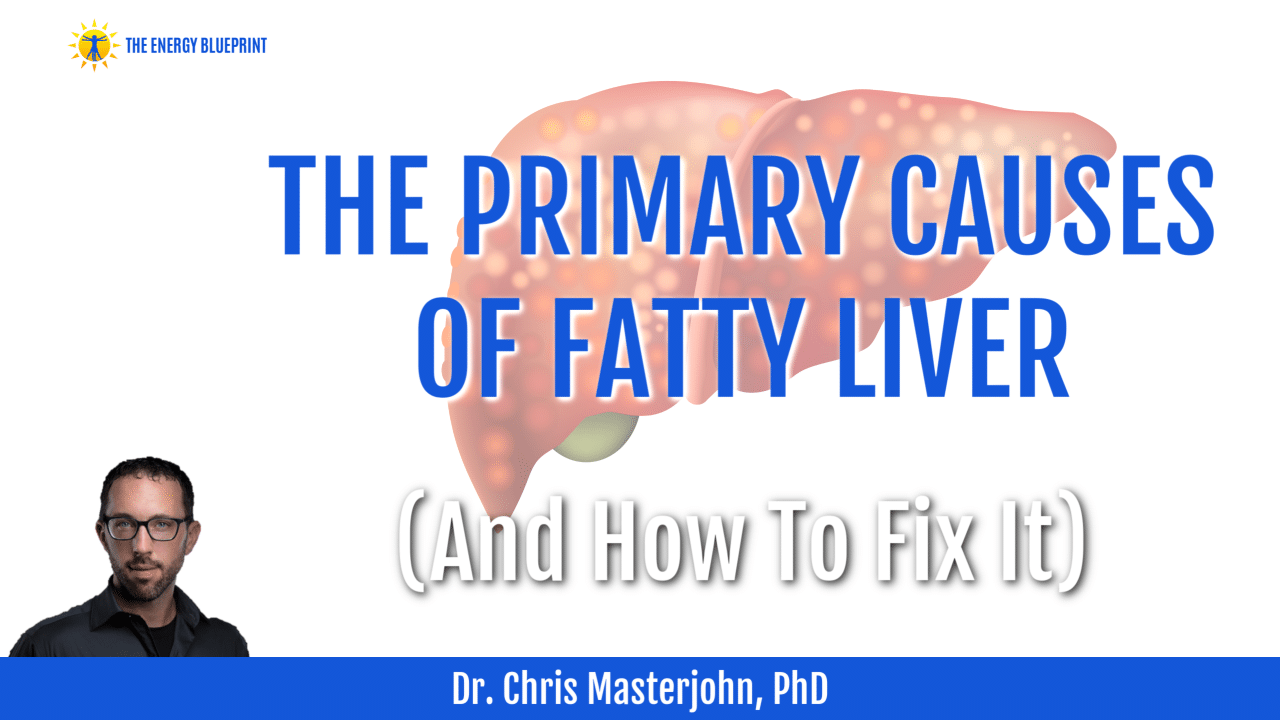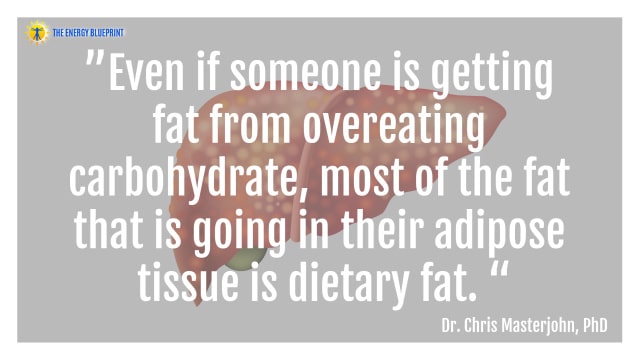
Dr. Chris Masterjohn has a PhD in Nutritional Sciences and is widely recognized as one of the world’s top experts in nutritional biochemistry. In this article, Dr. Masterjohn covers the primary causes of fatty liver and how to fix it.
This article is derived from the podcast The Science On Protein, Detox, MTHFR, Fatty Liver (And How To Fix It) and More with Dr. Chris Masterjohn Ph.D.
The primary causes of fatty liver
There are two primary ways fat gets into your liver.
- Stored fat gets released from your adipose tissue, travels through the liver, gets turned into triglycerides and is then sent back into the adipose tissue to get stored once more.
- Dietary fat travels through your lymphatic system and into the circulatory system. Dietary fat will always make it into the liver.
When fat gets into the liver, the liver transforms it into triglycerides. Fatty liver occurs when the liver can no longer export the triglycerides and the fat remains in the liver.
Another less significant factor that may contribute to fat in the liver is de novo lipogenesis—the process of converting carbs to fat. This only accounts for 5% of fat in the liver of a healthy person and up to 15% in a person with metabolic dysfunction. Unfortunately, this process often draws more attention than it should as low-carb advocates choose to focus on those 15% over the much more prevalent 85% that comes from dietary fat.
Key Point: There are two primary causes of fatty liver disease: the release of already stored fat from adipose tissue and the dietary fat you consume. Fatty liver occurs when the liver is no longer able to export the converted triglycerides. De novo lipogenesis only accounts for up to 15% of fat in the liver and is a minor contributor in the grand scheme of things.
“Fat doesn’t make you fat; carbs make you fat.”

The notion that it is carbs and not fat that makes you gain weight is highly inaccurate. When you eat more calories than you need, it doesn’t matter if they come from carbs or fat: you will gain weight either way. However, it is important to keep in mind that the fat that enters the adipose tissue is almost exclusively derived from dietary fat.
How is that possible?
Carbohydrates can result in weight gain because they prevent you from burning the fat in your diet. The fat is then locked in the adipose tissue, ultimately resulting in weight gain.
Key Point: It is dietary fat that is stored in your adipose tissue, not carbs.
The link between obesity and fatty liver
There is a direct link between obesity and fatty liver. This happens as you exceed your personal “fat threshold,” or the point at which you can handle excess energy and continue to efficiently store it as fat. Once you’ve exceeded that point, it becomes increasingly difficult for you to store the excess energy, resulting in unstored fat that floats around. In particular, visceral abdominal fat empties directly into the liver without ever entering the blood stream.
The main reason obesity so closely correlates with fatty liver is that visceral abdominal fat is constantly flooding the liver with fatty acids that can’t get out.
As a result, when you overeat and are in caloric excess, then otherwise minor factors such as de novo lipogenesis increase and become more significant contributors to fat in the liver.
Key Point: People who are obese are more likely to have fatty liver. This is in large part due to having exceeded their “fat threshold,” which makes it harder to store fat. In addition, visceral abdominal fat skips the blood stream and empties directly into the liver.
How to get fat out of the liver

A person with fatty liver disease experiences a 75% decrease in the liver’s ability to export fat from the liver, meaning a lot of the dietary fat that enters their body stays there.
So, how do you fix your liver?
Two factors play a role in getting fat out of the liver:
- Choline status
- Oxidative stress
According to Dr. Masterjohn, if you want to treat fatty liver, the most important thing you should do is attain a healthy body composition. To get from obese to healthy weight is the single most important thing that you can do to resolve fatty liver. Improving both your choline levels and antioxidant production in the liver may help you attain a healthy weight more efficiently. Choline helps get fat out of the liver whereas oxidative stress compromises your body’s ability to remove fat from the liver. (You can learn more about how oxidative stress affects your health in the podcast episode Dr. Masterjohn did on the internal antioxidant system.)
When your body fat is within normal ranges, the next step is to examine the total intake of dietary fat. Dietary fat is far more predisposing to fatty liver than dietary carbohydrates ever could be.
Furthermore, because fructose is more lipogenic than carbohydrates, the fastest way to increase the liver’s ability to export fat is by lowering sugar and fat intake. Once your liver functions optimally again and you are able to export all the fat normally, then it no longer matters where the fat comes from.
Key Point: Choline and oxidative stress are the two most important factors in controlling the liver’s ability to export fat from the liver. However, if you are overweight, it is important to bring your body weight back into normal ranges. Decreasing both sugar and fat intake is a great step to take to support this process.
Summary
Fatty liver disease occurs when the liver is unable to export fat. There are two main factors that contribute to fatty liver: a constant influx of stored fat that is released into the liver and consumption of dietary fat.
While the body does convert some carbohydrates to fat (through a process called de novo lipogenesis), this is not a primary cause of fatty liver — despite feedback from different health camps on the internet stating otherwise. The fat stored in the liver is almost exclusively from dietary fat.
Fatty liver disease most often occurs in people who are overweight or who have exceeded their personal “fat threshold.”
The best way to heal fatty liver is to lose weight, optimize choline levels, and bolster the antioxidant defense system.





